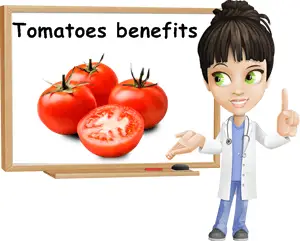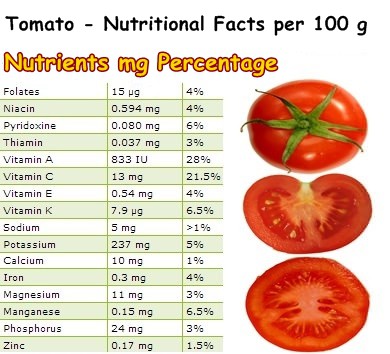For many of us, summer is synonymous with the sweet freshness of perfectly ripe tomatoes. I for one cannot imagine eating anything else on a hot summer day and even thinking about their earthy aroma makes me crave a few slices.
Fortunately, nowadays tomatoes are available almost all-year round, though it is best to eat them when they are in season in order to get the most of the health benefits they have to offer and enjoy their original flavor.
Believe it or not, tomatoes are a great source of several essential nutrients and antioxidants with multiple benefits.
Rich in vitamins A and C, tomatoes are particularly good for our eyesight and immune system as well as promote skin health. Both vitamins have antioxidant value as well and help protect cells against free radical damage and oxidative stress.
The generous lycopene content of tomatoes further adds to their antioxidant value and benefits for health.

Just a little more than a decade ago, they were seen as average vegetables, sweet and fresh indeed, but not worthy of much attention from a nutritional point of view.
However, things have changed significantly since then and researchers now show a growing interest in the health benefits of the plain tomato.
Recent research suggests that tomatoes are potent natural detoxifiers and believed to contribute to preventing some forms of cancer such as lung cancer or stomach cancer (Giovannucci E. Tomatoes, tomato-based products, lycopene, and cancer: review of the epidemiological literature. J Natl Cancer Inst. 1999).
These wonder-attributes rely on a powerful natural compound found in tomatoes called lycopene.
This compound has been proposed as a natural anticancer agent, able to prevent prostate, stomach and urethral cancer. What’s interesting is the fact that our body naturally stores lycopene in those specific organs which strengthens the argument investigates, that tomatoes are an anticancer food.
Lycopene indeed has scientifically proven antioxidant activities, namely preventing oxidative stress and associated cell damage which contributes to a lower risk of such forms of cancer.
Studies on the health effects of the antioxidant lycopene in tomatoes and tomato byproducts such as tomato juice, sauce, ketchup and others indicate a measurably reduced risk of stomach cancer as well (Erica N. Story, Rachel E. Kopec, Steven J. Schwartz and G. Keith Harris. An Update on the Health Effects of Tomato Lycopene. Annual Review of Food Science and Technology. 2010).
Tomatoes further contain an incredibly potent antioxidant called glutathione, known for its strong detoxification properties. Glutathione is highly efficient in fighting off the infamous free radicals responsible for cell damage, and research shows it offers a certain level of protection against cancer.
According to research, glutathione in tomatoes and other plant foods such as black radish and black radish juice helps repair damaged DNA and regulates cell life cycles, preventing cells from prolonging their life indefinitely which is essentially the definition of cancerous cells.
In other words, this antioxidant ensures cells do not live beyond their natural life cycle and thus do not end up turning cancerous.
Moreover, glutathione in tomatoes helps with protein synthesis. And since proteins are vital element of the immune system response, it too is great for boosting immunity. The antioxidant also helps transport amino acids from protein through the body to where they are needed, particularly the nervous system, providing benefits for mental health.

Tomatoes are known to help lower LDL (bad) cholesterol and even total cholesterol levels thanks to a good content of dietary fiber: 1.2 grams of dietary fiber per 100 grams of the fresh fruit with skin. Typically, 1 medium-small tomato weighs about 100 grams. Most of the fiber is in the skin, so eating the tomato whole, whether fresh or cooked, is the best way to ensure you meet you daily fiber requirements and enjoy good cholesterol levels.
Eating tomatoes also helps keep your blood pressure within normal limits by providing small amounts of dietary potassium to help regulate sodium levels in the body as well as intracellular fluid, with benefits for blood pressure. Most heart problems are caused by a high sodium intake and a low potassium intake. Those of you with hypertension or other heart conditions deriving from it, know that when your body gets enough potassium, you will enjoy good cardiovascular health.
The minerals ensures electrical impulses from the brain to the heart muscle are regular, resulting in your heart muscles beating regularly, which means no more heart rhythm problems. Potassium also balances sodium which leads to fluid levels in the body becoming balanced and high blood pressure going down.
Blood circulation also improves significantly with a good diet providing all essential nutrients. So cut down on the salty foods and eat some potassium-rich tomatoes, bananas or potatoes. Think about this: tomatoes are red, the color of blood, so they are good for the heart.

If you look at the nutrition table of tomatoes above you will see the culinary vegetable also contains small amounts of manganese: 0.15 milligrams per 100 grams which represents 6.6% of the recommended daily intake, RDI, of manganese as per the 2016 new RDI guidelines. Manganese is a great antioxidant dietary mineral mineral used by our body to detoxify superoxide free radicals, playing an important role in the prevention of oxidation stress and chronic disease in all its forms.
Furthermore tomatoes have small amounts of B vitamins, notably vitamins B1, B2, B3, B6 and B9. 100 grams of raw, ripe tomatoes provide roughly 9% of the recommended daily intake of vitamin B2 and around 4% of the RDI of most other B vitamins. What this means is eating tomatoes provides benefits for energy metabolism, digestive system and nervous system health.
The botanical fruit and culinary vegetable also contains impressive amounts of vitamin C, by far the most potent natural antioxidant and anti-inflammatory. 100 grams of raw tomato contains around 13 milligrams of vitamin C out of the 90 milligrams minimum recommended daily intake for an adult. And since you never eat just one tomato, you can easily get more of the nutrient. Benefits include better immunity, reduced inflammation, healthier skin, teeth and joints.
In addition to this, the fruit is rich in vitamin A and contains small amounts of vitamin K, both essential for good eyesight, healthy skin, blood coagulation and bone health. Last but not least, it is also a source of the antioxidant pigment and vitamin A precursor beta-carotene: 100 grams of tomatoes may contain 0.2 to 2.8 milligrams of beta-carotene. The human body processed beta-carotene and uses it as vitamin A for its powerful antioxidant properties and benefits for mucous membranes.
Lycopene, also responsible for the red color of tomatoes and found in generous amounts in them boasts strong antioxidant properties. However, in order for the body to be able to absorb lycopene, beta-carotene, other carotenes and even vitamin A, you have to eat tomatoes with a little bit of fat, whether it’s olive oil, butter, avocado or some beef or pork. What is most interesting is that, unlike other nutrients, lycopene needs to be cooked to provide the most benefits (find out more about the benefits of lycopene).
Of course, tomatoes aren’t just red. There are also beautiful yellow, orange, green, purple, black and even striped varieties. By far the most popular colors right now are purple and black. In addition being quite unusual colors for the fruit, colors that one would normally associate with the berries, these varieties are also sources of additional health benefits. Find out more about the benefits of black tomatoes.
What are the benefits?
Read below what are the best 9 benefits of eating tomatoes:
- Better immunity as a result of a good content of vitamins A and C.
- Good for eyesight and skin, possibly even acne, thanks to vitamin A.
- Reduces inflammation and promotes joint health thanks to vitamin C.
- Has lycopene with antioxidant and anticancer activity.
- Boosts energy as a result of small amounts of B vitamins, carbohydrates and sugars.
100 g of tomatoes has 3.89 g of carbohydrates and 2.63 g of natural sugars. - Benefits for digestion and constipation relief as a result of a good fiber content.
- Cholesterol and blood pressure-lowering properties.
- Tonic, energizing and detoxifying effects.
- Hydrating effects because tomatoes are 94.52% water.
Is tomato a fruit or a vegetable?
And now for the question on everyone’s minds: is tomato a fruit or a vegetable? From a botanical point of view, the tomato is a fruit, a berry to be more exact, but it is used as a vegetable in cooking.
If you want to choose the sweetest, most fragrant tomatoes try looking for those varieties that are a bit green on top. The light green colour near the stem is indicative of heirloom varieties of tomatoes, sweeter and overall more delicious than commercial regular size and cherry tomatoes, and is a sign that the fruit have not been cross-bred to ripen in an even red colour which causes a significant loss in sugar content.
Remember to always eat tomatoes in season and look for fresh, shiny, firm fruit with the characteristic green near the stem, no spots and a strong tomato smell. These will have a sweet taste and a delicious earthy, genuine tomato flavor.
